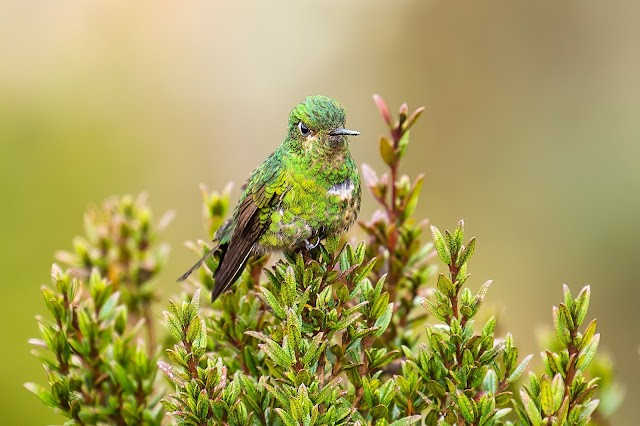Well, in spite of all the vaccines, boosters, masks, and rum we came down with COVID - except Jay for some inexplicable reason. Too many insalubrious interactions with lodge staffs, other birders, and probably each other in the end.
Initially, only one of us tested after feeling ill (HIPAA prohibits identifying her as Sue), so the rest of us leave for a date with the most recently discovered species of Trochillid, the Blue-throated Hillstar.
This Hillstar is a paramo specialist, of which there are several bird species, and we find ourselves after a mountainous drive clambering over a windswept grassy hillside at 11,500 feet altitude in the Andes. The Hillstar does not take long to appear, and the photogs all jockey for position to get a frontal shot, to limited success.
Hummingbirds often appear as if they were teleported, not there one second and there the next. Something to do with their speed of flight and our slowness of eye, I suspect, but it makes for excitement when it occurs on a bush that a group watches in anticipation.
A few more paramo specialists sweeten our visit, including a rare hummer, the Viridian Metaltail.
But our celebration of the Hillstar sighting and the wonder of Andean peaks is dampened when Sam relays the news that most of us tested positive for COVID. So we have to speed back to Guayaquil to isolate in a hotel and await a negative test.
After almost three weeks in the wilds and mountains of southern Equador, being limited to a 20 x 12 room is somewhat confining. Perhaps presciently I am reading A Gentleman in Moscow, about a political enemy of the Russian Revolution who is internally exiled to a single hotel. And I start to relate to his fears that “it would not take long for the ceiling to edge downward, the walls to edge inward, and the floor to edge upward, until the entire hotel had been collapsed into the size of a biscuit tin.”
A view of the paramo and Blue-throated Hillstar habitat at about 12,000 feet.
I have little or no symptoms, so I go through the so-called five stages of grief: Angry, Dopey, Sleepy, Grumpy, and Resigned (thankfully, no Sneezy). Fortunately I have several thousand photos to go through and I have Lightroom on my iPad to play with, and the 100 or more eBird checklists that Sue prepared to go through and reminisce about happier days.
But after seeing and hearing over 570 species of birds the last three weeks, a diet of one Turkey Vulture, one Ecuadorian Thrush, a flock of Southern Rough-winged Swallows, a few Scrub Blackbirds, two Tropical Kingbirds, several pigeons, and - painfully - numerous airplanes, is less than satisfying.
Next up, I hope: weird birds of the trip.
All photos © C.S. Wood










No comments:
Post a Comment